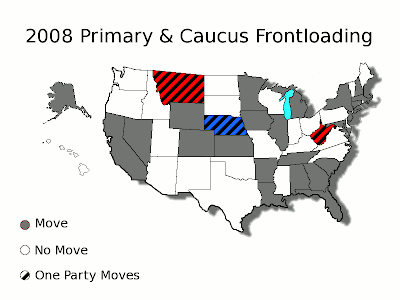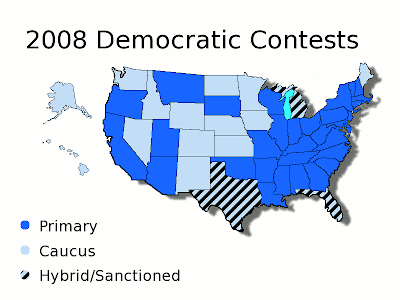Rob started things out by linking to Jay Cost's piece that tied the events surrounding the economic collapse this fall to other historical corollaries: the Civil War, the gold standard debate and the Great Depression. [There were some nice maps there -- even some that had Long Island colored differently than the rest of New York -- but I was left wondering where the maps for the most recent elections were. I like maps. What can I say.] Cost has not been alone in this realignment discussion. In fact, John Sides over at the Monkey Cage was recently bemoaning the overabundance of realignment talk in the press following last week's election.
That aside, our discussion here has centered on a few basic ideas:
1) A realignment does depend on some sort of lasting change.
2) Much of this talk rests with how well Obama does over the next four to eight years.
3) And finally, how lasting the shift is depends in part on how the GOP responds and who they line up behind as the face of that response.
Scott thinks there has been one change that is likely to last as a result of Obama's election, though stops short of calling it a realignment:
"Not a "realignment." But for lasting changes, I'd identify this election as the last gasp of the anti-intellectuals on a national level. The percentage of Americans who are college-educated keeps creeping up, so it didn't quite work this time to pit "real" people against "elitists"--there are too many who side with the elitists in that division. And the demographics there will keep tilting further and further toward the educated.But Jack disagreed:
"It was once possible to espouse a kind of populism that set workers against landowners--but eventually, demographics shifted so that now too many voters own homes, and any attack on property owners would be political suicide. We've just crossed that Rubicon with education, and we won't be going back."
"I don't think populism which plays to the uneducated is dead. But the increase in education certainly requires one to be more subtle. One can't go around insulting educated Americans, but you can get away with playing up the virtues of rural American values, etc.I fall in the middle on this one. I certainly see some of what Scott is talking about, but if you read the back end of Adam Nossiter's article in The New York Times today and then look at those nice county maps they put up last week, there's still an area of the country that is seemingly being left behind in terms of education. But as John McCain's electoral college coalition proved, that group of states from east Texas and then fanning out to capture the Deep South and Appalachia, is not really the basis of a winning formula in the future. Playing to those states as the main cog of an electoral college coalition isn't a winning strategy but incorporating them somehow in a broader coalition -- something similar to the Republican Party Colin Powell envisioned in his endorsement of Barack Obama on Meet the Press -- will be the only viable route. Of course, stories like that only buoy the hopes of Democrats. Whether that falsely buoys them depends in large measure on how well Obama does and who the Republicans put out there as the face of their party in 2010 and 2012.
"I've been reading a lot about the 'death of Rovian politics,' 'end of the politics of fear,' etc., and I've just had a hard time believing it. Just because it didn't work this year doesn't mean it will never work. After all, there were a lot of other reasons why McCain didn't win; they might work in a year in which the conditions are more favorable."
Rob drops the first bomb here:
"I heard on NPR that Newt Gingrich is planning on running in 2012. Here is a man who is brilliant and who can appeal to intellectuals as well as the uneducated. If Obama falters, Newt could be a very appealing candidate -- one who can appeal to the social conservatives despite his divorces. For those of you who think that 1996 finished him off, I point to the 1962 gubanatorial race where "you won't have Dick Nixon to kick around any more", Bill Clinton's career-ending speech at the 1988 convention, and Hillary Clinton's national reputation in 2000. A Gingrich/ Palin primary contest could be as entertaining as the Obama/ Clinton contest this year!"Indeed, but Gingrich may be trying for a kind of reverse Howard Dean effect here. He and former Maryland Lt. Governor Michael Steele are locking in a behind-the-scenes battle for the chairmanship of the RNC according to The Washington Times. To complete the reverse Dean effect though, Gingrich would have to lose this fight and then go on to win the GOP nomination in 2012. Throwing that idea out for a moment, if the former Speaker was to run in 2012, would that make Bobby Jindal the Mark Warner of 2012: an up-and-comer who drops out of the race before it even starts? And this on the heels of me thinking about Sarah Palin in terms of being a combination of John Edwards 2004 and John Edwards 2008. I think she has more Obama potential in her than Edwards though. But the next couple of years will give us a better idea as to whether she'll be a lasting figure in the GOP, much less someone who will attempt to prevent a lasting change from cementing.
Time will tell.
Recent Posts:
2008 Electoral College Wrap Up
How Stuff Works: An Alaska Vacancy in the US Senate
More on the Georgia Senate Runoff













